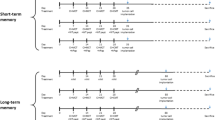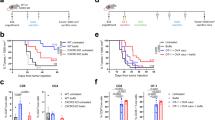Abstract
In an animal model, we evaluated the possibility to induce antibodies directed against the tumor-associated antigen CA125 by immunization with the anti-CA125 antibody OC125 via activation of the idiotypic network. Our results show that Balb/c mice, immunized by repeated administrations of F(ab′)2-fragments of the OC125 antibody (Ab1), produced anti-idiotypic antibodies (Ab2). The binding of these antibodies to the OC125 could be completely inhibited by the antigen CA125, suggesting that the anti-idiotypic antibodies imitate the original target antigen of the OC125. After induction of these paratopebinding anti-idiotypic antibodies (Ab2β), a murine IgG-anti-CA125 (Ab3) response arose in the same mice. The induction of idiotypic cascades offers the possibility of immunization against tumor-associated antigens without using the original antigen and breaking antitumor tolerance.
Similar content being viewed by others
References
Jerne, N. K. (1974)Ann. Inst. Pasteur Immunol. Sect. 125C, 373–389.
Jerne, N. K., Roland, J., and Cazenave, P.-A. (1982)EMBO J. 1, 243–247.
Bona, C. A. and Köhler, H. (1984) Anti-idiotypic antibodies and internal images, inMonoclonal and Anti-Idiotypic Antibodies: Probes for Receptor Structure and Function Receptor Biochemistry and Methodology, vol. 4. (Venter, J. C., Fraser, C. M., and Lindstrom, J., eds.), Liss, New York, pp. 141–149.
Cerny, J. and Hiernaux, J. (1990) Concept of idiotypic network: description and function, inIdiotypic Network and Diseases. (Cerny, J. and Hiernaux, J., eds.), American Society for Microbiology, Washington, DC, pp. 13–29.
Köhler, H., Kaveri, S., Kieber-Emmons, T., Morrow, W., Müller, S., and Raychaudhuri, S. (1989) Idiotypic networks and nature of molecular mimicry: an overview, inAntibodies, Antigens and Molecular Mimicry. (Langone, J. J., ed.), Academic, New York, pp. 3–35.
Koprowski, H. (1989) Basic aspects of immunotherapy of human tumors, inProgress in Immunology VII. (Melchers, F., ed.), Springer-Verlag, Berlin, pp. 1087–1096.
Varela, F. and Coutinho, A. (1991)Immun. Today 12, 159–165.
Wettendorff, M., Illiopoulos, D., Tempero, M., Kay, D., De Freitas, E., Koprowski, H., et al. (1989)Proc. Natl. Acad. Sci. USA 86, 3787–3791.
Reinsberg, J., Heydweiller, A., Wagner, U., Pfeil, K., Oehr, P., and Krebs, D. (1990)Clin. Chem. 36, 164–167.
Wagner, U., Reinsberg, J., Oehr, P., Briele, B., Schmidt, S., Werner, A., et al. (1990)Tumordiagnostik Therapie 11, 1–4.
Wagner, U., Oehr, P., Reinsberg, J., Schmidt, S., Schlebusch, H., Schultes, B., et al., (1992)Biotechnol. Ther. 3, 81–89.
Hamby, C. V., Liao, S.-K., Kanamaru, T., and Ferrone, S. (1987)Cancer Res. 47, 1054–1060.
Dillman, R. O., Beauregard, J. C., Halpern, S. E., and Clutter, M. (1986)J. Biol. Resp. Mod. 5, 73–87.
Pimm, M. V., Perkins, A. C., Armitage, N. C., and Baldwin, R. W. (1985)J. Nucl. Med. 26, 1011–1023.
Primus, F. J., Kelly, K. A., Hansen, H. J., and Goldenberg, D. M. (1988)Clin. Chem. 34, 261–264.
Schroff, R. W., Foon, K. A., Beatty, S. M., Oldham, R. K., and Morgan, A. C. (1985)Cancer Res. 45, 879–885.
Traub, U. C., DeJager, R. L., Primus, F. J., Losman, M., and Goldenberg, D. M. (1988)Cancer Res. 48, 4002–4006.
Perosa, F., Kageshita, T., Ono, R., and Ferrone, S. (1989) Serological methods to detect anti-idiotypic antibodies, inAntibodies, Antigens and Molecular Mimicry. (Langone, J. J., ed.), Academic, New York, pp. 74–90.
Koprowski, H., Herlyn, D., Lubeck, M., DeFreitas, E., and Sears, H. F. (1984)Proc. Natl. Acad. Sci. USA 81, 216–219.
Bhattacharya-Chatterjee, M., Chatterjee, S. K., Vasile, S., Seon, B. K., and Köhler, H. (1987)J. Immunol. 139, 1354–1360.
Lee, V. K., Harriott, T. G., Kuchroo, V. K., Halliday, W. J., and Hellstrom, K. E. (1985)Proc. Natl. Acad. Sci. USA 82, 6286–6292.
Chronides, A., Wagner, U., Mallmann, P., Schmidt, S., and Krebs, D. (1992)J. Cancer Res. Clin. Oncol. Suppl. 118, R17.
Author information
Authors and Affiliations
Rights and permissions
About this article
Cite this article
Schultes, B.C., Reinsberg, J., Wagner, U. et al. Idiotypic cascades after injection of the monoclonal antibody OC125. Cell Biophysics 24, 259–266 (1994). https://doi.org/10.1007/BF02789237
Issue Date:
DOI: https://doi.org/10.1007/BF02789237




